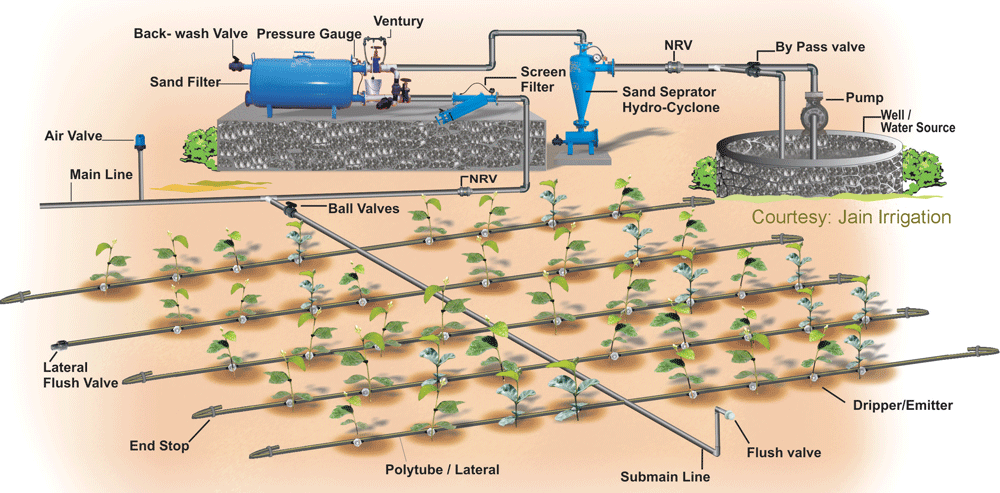Drip irrigation is one of the methods of irrigation in which water falls in the form of water droplets. Experts say that this method is discovered in Israel. This method is also known by another name trickle irrigation.
In drip irrigation pumps, pipes, valves, drippers and emitters are used. Usually, the discharge rate of water from a dripper is around 1-4 litres per hour. It is a wonderful method to save water. The main aim of this drip irrigation system is to save water and increasing the water application efficiency. There is around 60-70% water saving as compared to flood irrigation. A well-designed drip irrigation system is efficient as compared to other types of irrigation methods available.
This trickle irrigation is boon for acute water shortage regions. It is advisable to water arid or sandy soil as slowly as possible. This method completes this aim.
Working of Drip Irrigation
The above image shows the drip irrigation system used for watering a large land. In this system, the following major components are used.
- filter [optional]
- main line
- submain line
- Polytube/lateral line
- Dripper/Emitter
First of all water is filtered to remove sand particles. If water is not filtered the sand particles and minerals present in the water will get accumulated in the pipes and emitters. Hence it will block the supply of water after some time.
The filtered water is passed through the main line and distributed into many submain lines. The submain line is finally distributed into the lateral line which is placed along the row of plants on the land.
A dripper is fixed at each plant in the lateral line. Therefore the dripper will provide watering to the plants evenly across all the plants.
For small applications like terrace gardening or home gardening, the use of water filter is optional.
Drip Irrigation Applications
- Drip irrigation can be used in residential gardens for providing water in plant pots.
- Commercially this method of irrigation is employed in greenhouses and farms.
Drip Irrigation Advantages
- This method is good for a region where there is a water shortage.
- Since the water falls drop by drop and at a slow rate. Hence there will be less soil erosion and minimize the nutrients losses. Therefore reduces leaching.
- The requirement of fertilizer reduces.
- The delivery of water to the plant toots is more uniform.
- The crop matures faster and has good health.
- This method minimizes water evaporation.
- Higher water application efficiency.
- Weed population can be controlled using this method.
- In this method, water is first filtered and then supply to the main pipe. Hence the salt concentration is less.
- In this method, the dripper is placed at the roots of a particular plant. Hence no land levelling is necessary.
- Water supply can be easily controlled using valves and drippers.
- Along with irrigation, fertigation (applying fertilizers) and Herbigation (applying herbicides) can also be applied.
- Since water is applied at the roots, it causes a less humid environment and due to this foliage remains dry. Hence the risk of plant diseases decreases.
- Lesser labour cost as compared to other irrigation methods.
Drip Irrigation Disadvantages
- There is clogging of an emitter after some time mainly due to sand particles or slime accumulation if proper filter equipment is not used.
- There is a chance of damage to this irrigation system by animals mainly rodents including rats.
- The lifespan of tubes decreases as these tubes are placed under the sun most of the time.
- Salt accumulation near plants due to lack of sufficient moisture for leaching
- The initial cost for this irrigation technique is high.
- This method is most suitable for plants having wider spaced distance between them.
- This method can cause inadequate plant root development.

